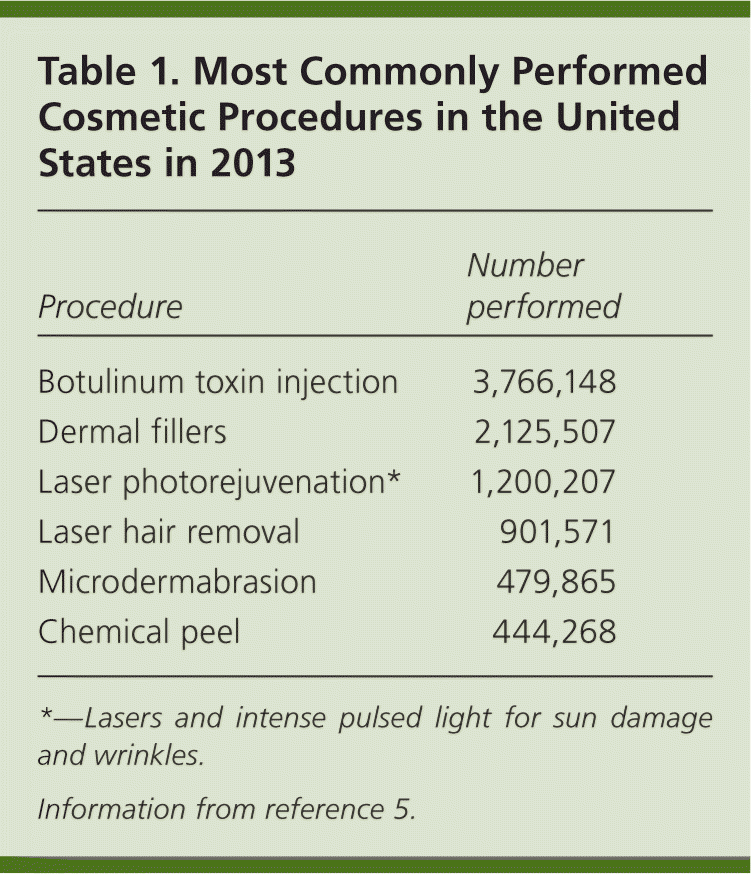
Am Fam Physician. 2014;90(3):136-137
See related article Botulinum Toxin Injection for Facial Wrinkles.
Author disclosure: No relevant financial affiliations.
In recent years, there has been an increase in the range of ancillary services offered by family physicians. Several factors have contributed to this trend, including the desire to provide more comprehensive patient care, patient demand for such services from their physicians, and practitioners' interest in expanding their skills. Services that have now become available through family physicians may include diagnostic procedures such as bone densitometry, Holter monitoring, and radiography, as well as other areas of medicine such as complementary and alternative medicine and physical therapy.1,2
For those physicians who enjoy performing procedures, some are choosing to incorporate aesthetic medicine into their practice,3 with surveys showing up to 22% of family physicians providing cosmetic procedures.2,4 The most common treatments are botulinum toxin and dermal filler injections, lasers for photodamaged skin and hair removal, microdermabrasion, and chemical peels (Table 1).5

| Procedure | Number performed |
|---|---|
| Botulinum toxin injection | 3,766,148 |
| Dermal fillers | 2,125,507 |
| Laser photorejuvenation* | 1,200,207 |
| Laser hair removal | 901,571 |
| Microdermabrasion | 479,865 |
| Chemical peel | 444,268 |
Office-based cosmetic procedures are in high demand in the United States. About 9.5 million nonsurgical cosmetic procedures were performed in 2013, an increase of 521% since 1997.5 This is in large part due to patient desire for a healthy and youthful appearance, and increased availability of minimally invasive therapies.
Adding cosmetic procedures, or any procedure, to an existing practice appeals to physicians for several reasons, including increased variety in daily practice, augmented revenue, and enjoyment from the hands-on nature of the treatments. From the patient perspective, the broadened range of services within one office increases convenience, and more importantly, patients often prefer to have their family physician performing procedures rather than someone new.
If one chooses to add cosmetic procedures into practice, it is important to know that, although they are not inherently difficult, they do take time to learn. Hands-on training to gain knowledge and procedural proficiency are recommended before performing the procedures. Many beginning clinicians start with procedures that are more straightforward, such as botulinum toxin injection for treatment of frown lines and lines in the upper face; temporary dermal fillers; and chemical peels.6
There are procedural books7,8 and training courses produced specifically for primary care physicians interested in aesthetics that are available through the American Academy of Family Physicians and The National Procedures Institute. Some family medicine residency programs, such as those at Louisiana State University and the University of California–San Francisco affiliate, Natividad Medical Center, currently have cosmetic procedure training included in their curricula.
Besides adequate training, one should be mindful of the minimum requirements necessary for providing cosmetic treatments, including the cost of equipment and the space needed for storage, particularly for lasers. Obtaining medical malpractice coverage for the desired procedures is also an important consideration and, for some, may increase premiums. As with any medical procedure, there are associated complications. Moreover, patients undergoing elective cosmetic procedures typically have less tolerance for complications.
Some may argue that cosmetic procedures are outside the core scope of family medicine and that they should be exclusively the domain of other specialties such as dermatology and plastic surgery. As with any medical procedure, cosmetic treatments vary in their complexity and risks and should be performed based on the physician's training and experience; referral to a specialist should be offered when appropriate. Another concern is that time dedicated to cosmetic procedures takes away from traditional family medicine care, such as prevention and management of chronic disease. The individual physician must decide how to allocate his or her time. However, it is unlikely that many family physicians will shift the focus of their practice exclusively to concentrate on aesthetic medicine. Rather, a scenario whereby interested physicians perform cosmetic procedures for their existing patient population is more likely.
Physicians choose to shape and tailor their practices based on patient demands, professional interests, and economics. Cosmetic procedures are one of the possible ancillary service options for those family physicians who enjoy performing procedures and choose to provide aesthetic care for their patients.
